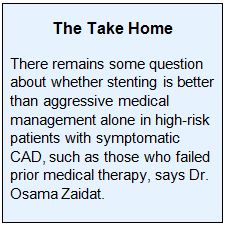Key Points:
- SAMMPRIS analysis focuses various subgroups of patients with symptomatic intracranial arterial stenosis
- No subgroup derives benefit from stenting plus aggressive medical therapy vs medical therapy alone
Aggressive medical therapy without the addition of percutaneous transluminal angioplasty and stenting (PTAS) provides better outcomes than does stenting plus medical therapy across subpopulations of patients with symptomatic intracranial arterial stenosis, according to an analysis of SAMMPRIS data published online September 17, 2015 ahead of print in Stroke.
The findings provide the “nail in the coffin” for use of stents in the treatment of intracranial arterial stenosis, said lead author Helmi L. Lutsep, MD, of Oregon Health and Science University (Portland, OR).
However, fellow SAMMPRIS study investigator Osama O. Zaidat, MD, of Froedtert Hospital (Milwaukee, WI), told WLNCMD in a telephone interview that certain high-risk patients may still benefit from stenting.
In SAMMPRIS, investigators randomized 451 patients with recent TIA or stroke attributed to stenosis of 70% to 99% in a major intracranial artery to either aggressive medical management alone (n = 227) or aggressive medical management plus PTAS using the Wingspan stent system (n = 224).
Enrollment was halted prematurely when interim analyses revealed improved outcomes for those who received aggressive medical management alone. At 30 days, the rate of stroke or death was 14.7% in the PTAS group and 5.8% with medical management alone (P = 0.002).
The current analysis was performed to determine whether stenting offered superior outcomes in any patient subgroups defined by sex, age, race, presence of diabetes, hypertension, or lipid disorders, smoking status, type of qualifying event, qualifying event hypoperfusion symptoms, and other factors.
There was no significant interaction between treatment effect and any of the baseline factors evaluated. Observed 2-year event rates were numerically higher among those who received PTAS in all subpopulations except for smokers (14.7% with aggressive medical therapy alone vs 14.3% with PTAS), patients who did not have lipid disorders (28.9% vs 27.6%), those with old infarcts in the territory (34.7% vs. 33.3%), and those with qualifying event hypoperfusion symptoms (7.0% vs 5.6%).
Questions Linger About High-Risk Patients
“This analysis was partly prespecified and partly post hoc based on the larger SAMMPRIS trial that showed that stenting wasn’t appropriate,” Dr. Lutsep told WLNCMD in a telephone interview. “It’s pretty clear that stenting is not appropriate [for intracranial stenosis].”
He noted that the VISSIT trial yielded similar results using a different stent (ie, the PHAROS Vitesse neurovascular balloon-expandable stent system). “That put to rest the idea that maybe it was the stent that was the issue,” Dr. Lutsep said. “I think given all the data now, it’s the end of stenting in this situation.”
But Dr. Zaidat pointed out that the SAMMPRIS trial “was not designed to test the hypothesis of [whether] stenting [is] better than optimal medical therapy in high-risk symptomatic CAD, such as patients who failed medical therapy with a hemodynamic presentation and high degree of stenosis.… This is a subgroup and post hoc analysis of a trial that was stopped early, with a small sample size and with the primary objective of looking at stenting versus medical therapy in patients who had stroke secondary to intracranial stenosis regardless of whether they failed medical therapy.”
The original trial did not closely evaluate medical therapy prior to randomization, explained Dr. Zaidat. “Therefore, it is not possible to determine who was on optimal medical therapy, how long they had been on therapy, how they responded to therapy (eg, whether they were responders to antiplatelets/antithrombotics), or even whether patients were compliant with therapy,” he said. “These questions were not asked.”
Given these limitations, “we should be very cautious in interpreting the study results,” said Dr. Zaidat. “Specifically designed prospective studies are needed to best identify the highest-risk group among intracranial atherosclerotic disease patients.” In the meantime, he said, “patients who continue to have clinical events attributed to intracranial stenosis in spite of medical therapy may still be treated with intracranial stenting or angioplasty in many centers.”
Source:
Lutsep HL, Lynn MJ, Cotsonis GA, et al. Does stenting versus aggressive medical therapy for intracranial arterial stenosis support stenting during medical therapy for subpopulations of patients with intracranial arterial stenosis? Stroke. 2015;Epub ahead of print.
Disclosures:
- Drs. Lutsep and Zaidat report no relevant conflicts of interest.


